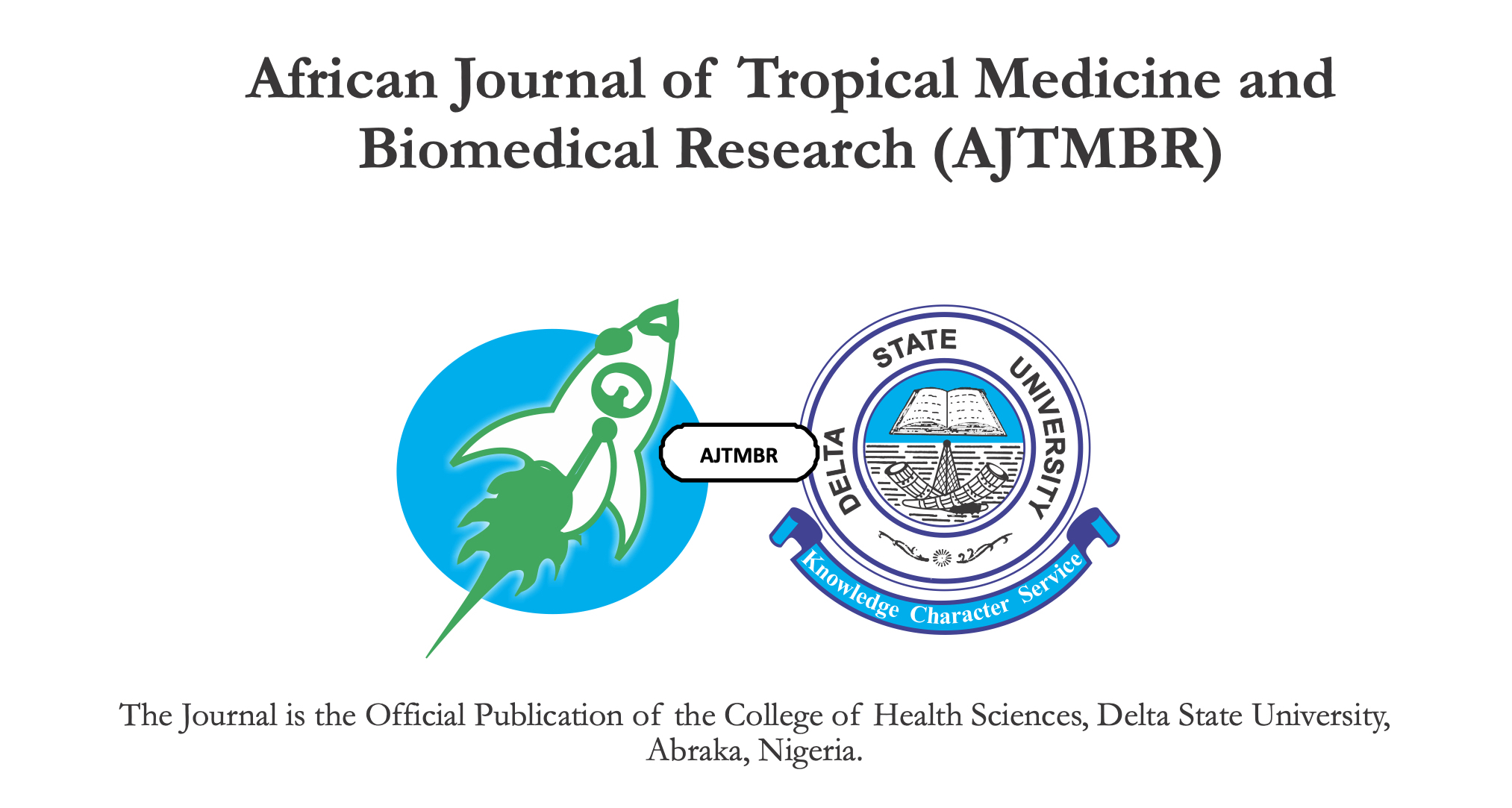Environmental and Socio-demographic Determinants of the Age at Menarche among Secondary School Girls in the Niger-Delta Region of Nigeria
Keywords:
Environmental, menarche, determinantsAbstract
Background: Menarche is one of the most significant events in the transition to re productive capability. It is believed to be influenced by genetic, physiological, environmental and social factors.
Methods: It was a cross-sectional survey over a two month period of two cohorts of 400 secondary school girls from two different communities of Rivers State Nigeria to determine the age at menarche and identify any peculiar environmental or socio-economic variables that may influence this.
Results: The mean menarcheal age (years) for the respondents from school ‘A’ was 13.99 + 1.060SD and that for school ‘B’ was 14.53 + 1.148 SD. The earliest age of menarche was 9 years for school ‘A’ and 11 years for school ‘B’. The latest age of menarche of 17 years was same for both schools ‘A’ and ‘B’. Only one respondent who is an athlete from school ‘A’ was involved in strenuous physical exercise, she was 14 years old and had not attained menarche. The differences in the post-menarcheal mean heights and weights of the respondents from schools A and B at their current ages were statistically significant and when compared against a standard female nomogram for height and weight, there were more small framed respondents from school ‘B’ compared to the individuals from school ‘A’.
Conclusion: Respondents from the more affluent background had significantly lower age of menarche than girls from the less affluent setting. Better socio-economic status, nutrition, greater height and weight are positively associated with a lower age of menarche.
References
Prakash C, Srivastava B, Gaur S, Bala R, Rai A, Roham. Age of menarche in girls Uttarakhand. J Indian Acad Forensic Med, 32 (1): 49-51.
KapoorAK,KapoorS.Theeffectsofhigh altitude on age of menarche and menopause. Int. J. Biometeor., 1986; 30: 21.
Adetokunbo OT, Oluwarotimi IA, Lukeman AJS, Osinusi BO. Appraisal of menstrual awareness and pattern among female secondary school students in Lagos. Scientific Research and Essay, 2009, Vol. 4 (11), 1271-1274.
Padez C, Rocha MA. Age at menarche in Coimbra (Portugal) School Girls: a note on secular changes. Ann. Hum. Biol. 2003; 30(5): 622-632.
Chowdhury S, Shahabuddin K, Seal AJ, Talukder KK, Hassan Q, Begum RA, et al. Nutritional status and age at menarche in a rural area of Bangladesh. Ann Hum Biol 2000; 27: 249-256.
Ikaraoha CI, Mbadiwe IC, Igwe CU, Allagua DO, Mezie O, Iwo GTO, et al. Menarcheal age of secondary school girls in Urban and Rural areas of Rivers State, Nigeria. Online J Health Allied Scs. 2005; 2:4.
Padez C. Secular trend in Portugal. J. Hum. Ecol. 22 (1): 15-22.
Hauspie RC, Vercauteren M, Susanne C. 1996. Secular changes in growth. Horm Res 45 (Suppl 2):8–17.
AkingbaJB.Someaspectsofmenstruation in Nigerian females. J. Nig. Med. Assoc.1968, 5: 27-32.
Oduntan SO, Ayeni O, Kale OO. The age of menarche in Nigerian girls. Annals Human Biol.1978. 3, 269-274.
Sogbamu MO, Aregbesola YA. Menarcheal age in Nigerian girls: Its relationship to their height, weight and menstrual profile. Int. J. Gynaecol. Obstet. 1979. 16: 339-340.
FakeyeO.Theinterrelationshipsbetweenage, physical measurements and body composition at menarche in schoolgirls at Ilorin. Int J Gynaecol Obstet. 1985; 23(1):55- 58.
Marinho AO. Menarcheal age, height, weight, dysmenorrhoea and menstrual regularity in Nigerian School Girls. Trop J of Obstet. Gynaecol. 1984. 4:1-8.
Wright EA. Menarche in Plateau State of Nigeria. West African J of Med. 1984. 9 (3): 204-207.
Ikechebelu JI. The age of menarche in Nigerian school girls, its relationship to socio- economic status with comments on the secular trends. Orient J Med 1991; 1: 182-185.
Goon DT, Toriola AL, Uever J, Wuam S, Toriola. Growth status and menarcheal age among adolescents school girls in Wannune, Benue state, Nigeria. BMC pediatrics 2010, 10:66. http//www.biomedcentral.com/1471- 2431/10/60.
Abioye-KuteyiEA,OjofetimiEO,AninaOL, Kio F, Aluko Y, Mosuro O. The influence of socio-economic and nutritional status on menarche in Nigeria school girls. Nutri Health. 1997, 11: 186-195.
Dare FO, Oguniyi SO, Makinde OO. Biosocial factors affecting menarche in mixed Nigerian population. Cent Afri J Med. 1992; 77-81.
Toriola AL, Mathur BN. Menstrual dysfunction in Nigerian athletes. Br J Obstet Gynaecol 1986; 979-985.
Stager JM, Hatler LK. Menarche in athletes: The influence of genetic and pre-pubertal training. Med Sci Sports Exerc. 1998; 29:269-273.
Frisch RE. Population, food intake and fertility.Science,1978.199:22-30.

Downloads
Published
Issue
Section
License

This work is licensed under a Creative Commons Attribution-NoDerivatives 4.0 International License.
Key Terms:
- Attribution: You must give appropriate credit to the original creator.
- NonCommercial: You may not use the material for commercial purposes.
- ShareAlike: If you remix, transform, or build upon the material, you must distribute your contributions under the same license as the original.
- No additional restrictions: You may not apply legal terms or technological measures that legally restrict others from doing anything the license permits.
For full details, please review the Complete License Terms.



